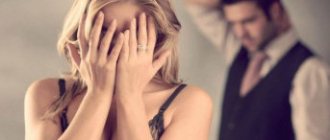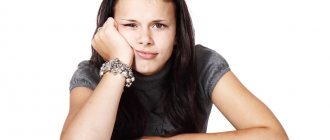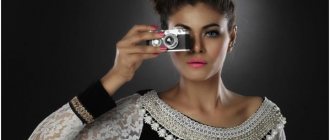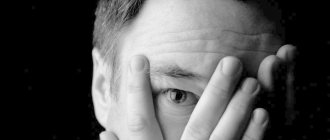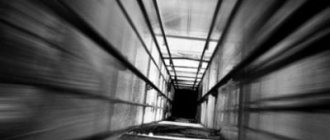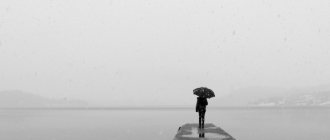A small number of people, about 1% of the world's population, are affected by this disease. Adequate therapy allows you to completely get rid of this sinister disorder. When the start of treatment is delayed, serious consequences develop that are dangerous to a person’s health and social activity.
What is heliophobia?
Heliophobia is the fear or fear of the sun and its rays. Not to be confused with Gunther's disease. Heliophobia is a disease of a psychological nature, while Gunther's disease is a mutation at the human genetic level. Heliophobia does not cause any damage to the skin and does not harm the body. After a person with Gunther's disease is exposed to the sun, burns and scars appear on the body, and if the disease progresses intensively, the ears, fingers and tendons become deformed.
With heliophobia, a person feels that the sun is causing him pain, leaving burns, and the sun’s rays seem to be crushing him. The disease can also be confused with another pathology – xeoderma pigmentosum. In this case, the disease develops from childhood and is the cause of the tumor and other phobias associated with the fear of light.
Fear of daylight hours
Bright light hurts the eyes of most people. They begin to squint, there is lacrimation and pain. This is quite normal, since our vision is designed for a certain light flux.
The fear of light is called photophobia. But this is not necessarily a mental disorder. Photophobia can be caused by various diseases:
- frequent headaches;
- meningitis;
- botulism;
- Gunther's disease;
- intoxication of the body;
- brain tumor;
- eye diseases.
Most of the pathologies are serious and dangerous, they require medical intervention, but they are not phobic disorders. Possible pain in the eyes, discomfort in bright light, and other acute reactions to lighting.
In which disease do signs of fear of light appear most often? It depends on the clinical picture and individual characteristics. In the acute phase, photophobia is especially painful, and the most common cause is eye pathology. Conjunctivitis, keratitis, glaucoma, mechanical disorders cause fear of light. These manifestations are associated only with physical pain, so we can only talk about a phobia conditionally.
Note: Fear of bright light is also influenced by genetic characteristics. For example, with congenital melanin deficiency in albinos, with a light iris, in some cases with color blindness, people cannot stay in the light for a long time.
Treatment of photophobia
If the fear of light is caused by a disease of the visual organs, then after their treatment the phobia will disappear by itself. Treatment uses eye drops that relieve inflammation and moisturize the cornea, and antibacterial drugs when the disease is infectious in nature. The method and duration of therapy depends on the specific problem.
During the treatment period, a number of recommendations should be followed:
- Wear sunglasses with 100% UV protection.
- Wear individually selected photochromic lenses.
- Keep your eyes clean by performing all hygiene procedures.
- When working at a monitor, use special glasses and perform eye exercises.
- If the cornea is dry, use moisturizing drops.
These simple rules will help you overcome the disease and at the same time recover from false phobia.
Reasons for development
Fear of sunlight (heliophobia) most often occurs in humans against the background of other phobias and diseases:
- Fear of diseases caused by exposure to sunlight (melanoma, skin cancer, cataracts, burns);
- Fear of large open spaces (agoraphobia), heliophobia in this case is a concomitant disease;
- Vision pathologies in which sunlight causes discomfort and pain. If a heliophobe has ever encountered unpleasant sensations caused by the sun, he may develop a fear of the sun;
- Schizophrenia. With schizophrenia, various types of phobias often arise, and heliophobia is no exception.
In rare cases, the disease develops independently, without apparent reason, suddenly. If some unpleasant incident happened to a heliophobe while in the sun, the person can relate it to daylight. First, anxiety and fear appear, and then the disease expands in scope and eventually grows into heliophobia. As a result, a person tries not to be outside during the daytime, spending most of his time at home.
In the initial stages, heliophobia can easily be confused with other diseases: photophobia and fengophobia. Although the symptoms are similar for everyone, there are differences. Therefore, when examining a patient, the doctor must carefully examine his condition, symptoms, and whether there are any strange obsessions.
Causes and Effects
Fear of the sun with heliophobia is unfounded, irrational, that is, it does not pose a real threat. Such fear can arise in an individual’s head under the influence of several reasons:
- presence of another phobia. More often these are fears from the hypochondriacal group, for example, the fear of developing skin cancer under the influence of ultraviolet radiation, especially when it is most aggressive;
- negative experience. “Sun fear” may well be the outcome of inappropriate spending time in the sun. An unsuccessful tan, resulting in severe burns on the skin, can not only extinguish the desire to sunbathe in the future, but also develop a persistent phobia of the celestial body. Heat strokes with a subsequent increase in temperature, nausea, and dizziness also give rise to a negative experience. Overheating, accompanied by delusions and hallucinations, further forms persistent, deep convictions of negative solar influence;
- One cannot exclude childhood psychotrauma as the cause of the birth of heliophobia. Moreover, the role of the sun in this situation may turn out to be secondary; the child has simply transferred it from a background meaning to a significant figure. Example: a boy was walking down the street on a hot summer day when the sun was in its active phase. Suddenly, a huge, ferocious dog appeared from around the corner, rushing towards the baby. The boy was madly frightened of the terrible animal, but the scorching sun was “stuck” in his subconscious, firmly embedded in the picture of the incident. Subsequently, the child developed a phobia, but not in relation to the dog, but in relation to sunlight.
In the case when a child receives severe heatstroke with hallucinatory phenomena, the formation of a phobia is also possible. But in this case, the baby perceives the luminary as something fantastic, unreal.
The fear of the sun can be instilled in a person in childhood by parents who terrorize their child about putting on a Panama hat, systematically instilling in them that if they go outside without it, the child risks being incinerated to ashes.
The girl developed heliophobia after removal of a thyroid tumor. Fearing that she would acquire a malignant tumor again, she went to extremes.
With heliophobia, there is no real danger to a person from the sun. The problem is created by the patient’s behavior itself, which limits his life activity, which leads to undesirable consequences.
By limiting exposure to light, a person runs the risk of developing vitamin D deficiency, since the latter is synthesized in the human body under the influence of insolation. This means that he will soon experience disruptions in the functioning of the body, leading to:
- softening of tooth enamel, caries, tooth decay;
- fragility of bones, their deformation, tendency to fractures;
- weight loss;
- fatigue;
- hyperhidrosis;
- muscle cramps.
Often, with heliophobia, the patient's sleep and wakefulness patterns are disrupted: he is active at night and sleeps during the day. This mode slows down the production of melatonin, since the hormone is synthesized at certain hours during sleep: between 24.00 and 5 am.
Melatonin is vital for the human body, as it is involved in many processes. This hormone regulates the activity of the endocrine system, biorhythms, and affects mental and physical activity. It controls our emotions, regulates blood pressure, and controls the functioning of the entire body. Consequently, when melatonin synthesis is disrupted, its functions and control are lost.
As for the social life of a heliophobe, detachment from society and being in a confined space leads to a severance of friendly and business ties and to complete isolation. Depression thrives against the backdrop of loneliness. A person is in a state of constant tension and fear. In this case, photophobia can reach the point of delusional ideas.
A common consequence of the disorder is the development of other phobias:
- social phobia – fear of people;
- agoraphobia - fear of open spaces.
People suffering from photophobia are unable to live a full life. The disease deprives the person of the opportunity to choose leisure at will, engage in professional activities, study, devote leisure time to entertainment, and hobbies. Starting a family and having children is also difficult. Any activity that requires execution during the daytime is at risk.
Symptoms of a fear of sunlight
Heliophobia is a dangerous social disease specifically for the heliophobe. The main symptoms of the disease:
- since the body does not receive vitamin D, human skin is very pale;
- there is increased sweat production with heliophobia;
- heliophobe has a pronounced stoop;
- teeth are deformed, have caries;
- a person very quickly loses body weight and experiences weakness, lethargy at the time of heliophobia;
- bones break easily and often;
- muscle cramps occur.
Also, a person with heliophobia independently isolates himself from society, does not leave the house during the daytime, and the time of wakefulness and sleep often alternates. He most often sleeps during the day and is awake at night. The number of friends is rapidly falling, and it is almost impossible to find a good job. Heliophobes try to constantly cover their heads with a hood, hat, etc. The general condition is also complicated by frequent intense panic attacks with heliophobia.
If a person with heliophobia comes under the sun's rays, then the following clinical manifestations are possible:
- Breathing and heart rate increase rapidly;
- There is dizziness;
- The appearance of nausea with bouts of vomiting;
- Strong fear for your health and life at the time of heliophobia;
- The desire to hide from the sun's rays.
If the heliophobe is not taken to a dark, closed room in a timely manner, then loss of consciousness and even hypertensive crisis and arrhythmia are possible.
Also, as a result of a lack of vitamin D, the heliophobe experiences constant headaches, chronic weakness and fatigue, and depression over time.
Manifestation of heliophobia
- All behavior of a person suffering from heliophobia is aimed at avoiding places illuminated by the rays of the sun. Being in a sunny area can cause a panic attack.
- Heliophobes prefer to leave the house only after sunset. In this regard, the sleep and wakefulness patterns are disrupted, the hormonal system malfunctions, and the production of an important night hormone, melatonin, decreases.
- Due to emotional stress, fear and constant expectation of negative consequences, a person begins to feel as if the sun is really physically pressing and burning.
- In an attempt to avoid the slightest exposure to ultraviolet radiation on the skin, the patient wears clothing that hides the body as much as possible.
Complications of the disease
Complications of heliophobia are expressed in the lack of socialization. People with a fear of light cannot enter a university or school, since they all work only during the daytime. There is also no opportunity to get a high-paying job, or only on night shifts. But the health of the heliophobe suffers most of all. The body does not produce calciferol, there is not enough vitamin D, which only worsens the condition every day. Fear, depression, chronic fatigue can turn into schizophrenia. Then the heliophobe will be dangerous not only for himself, but also for loved ones and people around him.
The sun is medicine
The fact that under certain conditions the sun can harm a person cannot be denied. However, the star that warms the Earth deserves a positive attitude more than fear. The sun not only heals the human body, but also helps people get out of difficult situations.
In those days when there were no navigational instruments yet, the sun served as a reliable means of orientation on the ground. Not only the heavenly body itself helped a person determine the coordinates of his position, but also the shadows that appeared on a clear day.
The sun makes it easier for people to fight various parasites . For example, bright sunlight dries helminth eggs located on the soil surface, which significantly reduces the risk of being caught. Dust mites also cannot tolerate sunlight. When fighting this microorganism, the sun helps disinfect bedding or soft toys.
In many developing countries, the solar disinfection method (SODIS ) is used to purify water. When exposed to sunlight, pathogenic microorganisms in drinking water die. This method is cheap, effective and accessible.
Diagnosis of heliophobia
Timely and accurate diagnosis of the disease is the basis for a quick and successful recovery. Since in the initial stages the symptoms of heliophobia are similar to other concomitant diseases and phobias, it is quite difficult to recognize it. Only a highly qualified doctor can recognize it by conducting a series of studies.
Among them:
- test to determine the degree of anxiety “rank scale”, the most common method for determining the presence of heliophobia;
- studying the daily routine and living conditions of a heliophobe;
- studying situations during which anxiety appears in heliophobia.
Based on all the results obtained, the specialist receives a complete picture of the symptoms and causes of heliophobia. They help determine the presence of a phobia and its type.
Therapy
Heliophobia requires professional help, especially at the initial stage of treatment. Treatment of the disease is carried out on an outpatient basis. Hospitalization is rarely necessary when the situation reaches a critical point.
Treatment of the disorder primarily comes down to the use of psychotherapeutic methods :
- Cognitive behavioral therapy uses the method of immersing the client in a traumatic situation and teaching how to get out of it using rational methods. Immersion, that is, access to the sun, is carried out gradually.
- Psychoanalysis will help reveal the underlying cause of the disorder and get to the bottom of it.
- Hypnosis is considered a particularly effective treatment for phobias. In a short period of time, it allows you to eradicate the problem without much effort for the client. By putting a person into a trance state, the specialist gets the opportunity to work with his unconscious. The hypnotherapist is thus able to influence a person’s ingrained attitudes acquired in childhood, identify traumatic events, change the patient’s attitude towards fear and help form an adequate model of behavior. For the client, this method is considered gentle because it does not cause tension or anxiety, and the treatment process is hidden from the patient’s consciousness. He is given the opportunity only to enjoy the result.
- In the compensated stage of the disease, auto-training and relaxation activities are available for patients.
Drug treatment is used in some cases. For depression, antidepressants are prescribed. To relieve panic attacks, the patient must be prescribed anti-anxiety medications. To relieve emotional stress, sedatives are used.
Most heliophobes take vitamin D to smooth out developing hypovitaminosis or compensate for it with nutrition.
Heliophobia is a mental disorder with a favorable prognosis. Stopped at an early stage, the disease goes away without a trace. The advanced form is dangerous because it causes disturbances in the mental activity of the patient.
Medical therapy
Timely diagnosis and treatment will help you quickly get rid of this unpleasant disease. Typically, heliophobia can be successfully treated by a psychoanalyst, but in more severe cases, complications that arise require drug therapy. Therefore, it is necessary to consult a doctor as early as possible, then the return of the heliophobe to his previous normal life will come faster.
At the mild and initial stage of treatment for heliophobia, conversations with a psychotherapist are enough. In more complex situations, you will need to combine psychotherapy with medication.
Psychotherapy for heliophobia is based on:
- Using hypnosis on a patient. Introducing a heliophobe into a hypnotic state helps on a subconscious level to increase his confidence in his own strength, as well as reduce fear, anxiety and a negative attitude towards sunlight.
- Self-hypnosis. The heliophobe independently convinces himself that the sun's rays do no harm and are not dangerous.
- Overcoming heliophobia through gradual contact with the sun.
- Therapy, the basis of which is to encourage a person to go outside during the daytime.
- Instill in the heliophobe the manner of copying the behavior of healthy people and their exposure to the sun.
All methods of psychotherapy for heliophobia are psychological, based on changing the attitude towards the sun's rays on a subconscious level. If such therapy does not produce positive results, then the use of medications becomes mandatory.
Drug therapy for heliophobia includes:
- taking vitamin D is necessary to normalize the synthesis of calciferol in the body;
- for panic attacks, anxiety and fear, sedatives are prescribed. Most often these are motherwort, valerian and mint; their advantage is that they are not addictive for heliophobia;
- Taking a beta blocker is necessary to reduce the effects of panic attacks at the time of heliophobia. The most inexpensive and effective drug is “Anaprilin”; it costs up to 50 rubles, but does an excellent job of normalizing heart rate and blood pressure. It is contraindicated in patients with asthma, diabetes and pregnancy;
- antidepressants. Taking anti-depression medications for heliophobia is mandatory. The most common and effective is Clomipramine. The drug is in the price category of 200-230 rubles. It has such contraindications as the presence of arrhythmia, prostate hypertrophy, glaucoma and frequent changes in cardiac tone.
Compliance with the treatment regimen for heliophobia gives very positive results.
Relationship with other phobias
Heliophobia can provoke the development of agoraphobia, that is, fear of open space. A person who does not have special knowledge may confuse the fear of the sun with phengophobia. However, fengophobes are not afraid of the sun itself, but of solar exposure.
Heliophobia also has features similar to photophobia - the fear of light in general. All three disorders can be either independent diseases or interrelated.
In some cases, heliophobia is the result of cancerophobia - the fear of developing a cancerous tumor.
The danger of this phobia is that it leads to serious health problems. Without exposure to ultraviolet rays on the skin, the body does not produce vitamin D, therefore, calcium is not absorbed and bone tissue is not strengthened.
Without sunlight, the human immune system weakens significantly, and the removal of heavy metal salts from the body slows down.
Due to the lack of sunlight, the hormone serotonin is not synthesized, which negatively affects the emotional health of the heliophobe.
Ultraviolet radiation has antibacterial properties , so the lack of sunlight makes it more difficult for the body to cope with various wounds and damage to the skin. Lack of vitamins provokes severe headaches, constant physical malaise and depression.
Heliophobia also negatively affects a person's social activity . With a fear of the sun, people cannot live a full life, communicate with others, work or study.
Prevention of fear of light
The main point of successful prevention against heliophobia is the support of loved ones. Walking in the sunny daytime will help consolidate in the subconscious the association of positive emotions with the sun.
It is also recommended for people who have suffered from heliophobia and to prevent it:
- Reduce consumption of energy drinks, alcohol and caffeinated drinks.
- Try to reduce the amount of negative emotions and stress.
- Walk more during the daytime and play sports.
- In case of anxiety and fear, share with family and friends.
You shouldn’t isolate yourself; it is possible to overcome heliophobia. But the main thing is to have the desire to do this, and to strive to ensure that the disease does not take over a person’s entire life.
Some tips
If a person who is afraid of the sun and sunlight finds himself on the street for certain reasons, during an attack of the disease it is necessary to take him to a darkened place or closed room, otherwise his health condition may worsen to the point of a hypertensive crisis, loss of consciousness, or severe arrhythmia.
To avoid relapse of heliophobia:
- it is necessary to avoid drinking energy drinks, alcoholic drinks, coffee;
- spend more time in sunlight, play sports;
- avoid stress and negative emotions;
- experiencing fear and anxiety to share with loved ones.
With timely, wise treatment, heliophobia can be fully recovered. And a properly selected course is the key to restoring physical and psycho-emotional health.
0

